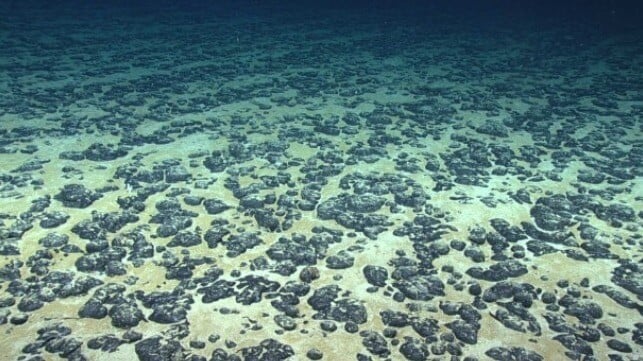With Support From Japan, Oceanographers Resume Study of "Dark Oxygen"

Japan's Nippon Foundation plans to fund a new study of "dark oxygen," the recently-discovered ability of polymetallic nodules to separate water into hydrogen and oxygen. The small black nodules are coveted by deep-sea miners, who hope to make a fortune off of a new and abundant source of valuable metals - but oceanographers and environmentalists are not so sure.
Last year, a team of researchers led by Prof. Andrew Sweetman of the Scottish Association for Marine Science (SAMS) visited the Clarion-Clipperton Zone on a project funded by The Metals Company, which hopes to mine nodules in the area. In the course of the study, Sweetman's team reported an entirely new source of oxygen production in the abyssal plain, previously unknown to science: the nodules themselves, which appear to have electrolytic properties.
For decades, scientists have believed that photosynthesis created all of the free oxygen in earth's natural environment. A new oxygen source in the pitch-black depths, where photosynthesis is impossible, would have been inconceivable up until last year. Even Sweetman disbelieved his own data during previous trips, writing off the anomalous high oxygen readings as a sensor error - but persistent evidence and multiple tests convinced him otherwise. If proven, his find could force a rethink of science's understanding of the origins of life.
"Through this discovery, we have generated many unanswered questions and I think we have a lot to think about in terms of how we mine these nodules, which are effectively batteries in a rock," Sweetman said last year.
His findings are as-yet unconfirmed, and controversial - especially with certain deep-sea mining companies, which have built a business model around removing the nodules for processing and sale. Several attempts to confirm or rebut Sweetman's findings are under way.
Now, with support from the Nippon Foundation, Prof. Sweetman and his team are heading back to the Clarion-Clipperton Zone to answer some additional questions. The team is building a lander that they will deploy at a depth of up to 36,000 feet to collect water samples, which will help confirm their oxygen readings. They will also check for dark oxygen production in other seabed environments, look for signs of extra dissolved hydrogen - the other product of splitting water in two - and will check for possible microbial oxygen-producers to make sure that the nodules really are the source.
"If we show that oxygen production is possible in the absence of photosynthesis, it changes the way we look at the possibility of life on other planets too," said Sweetman in a statement. "Indeed, we are already in conversation with experts at NASA who believe 'dark oxygen' could reshape our understanding of how life might be sustained on other planets without direct sunlight."
